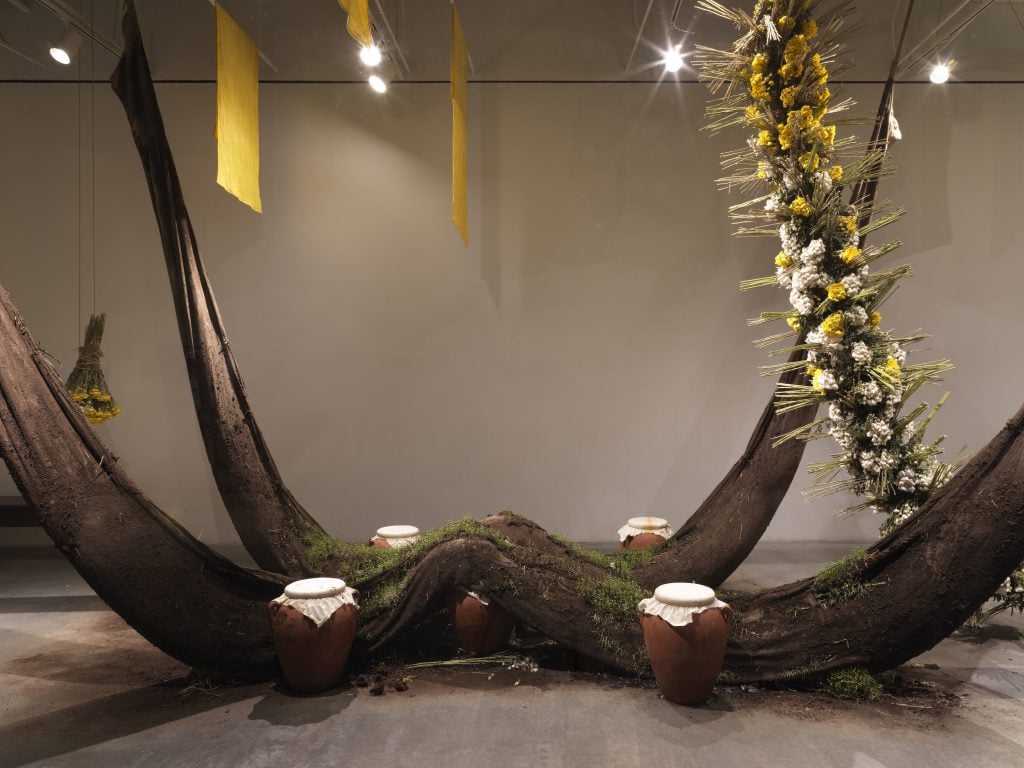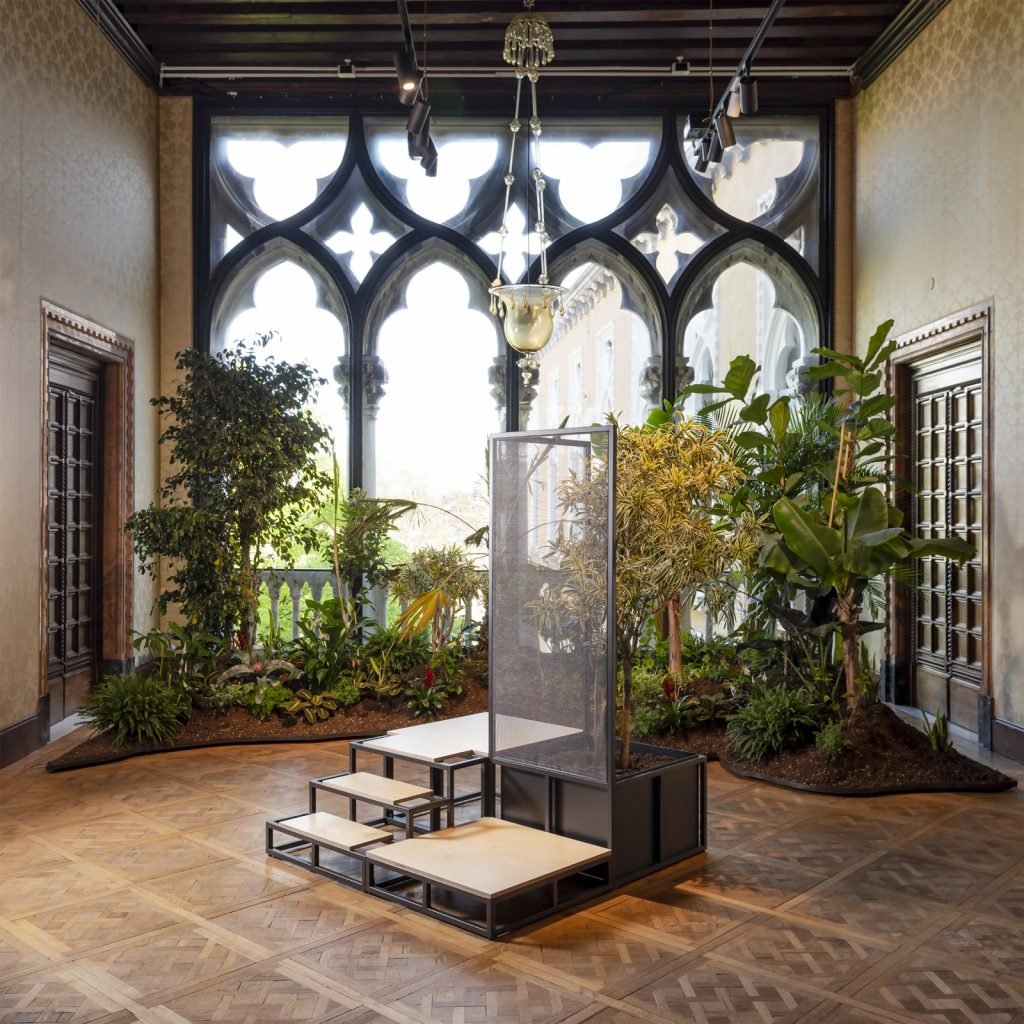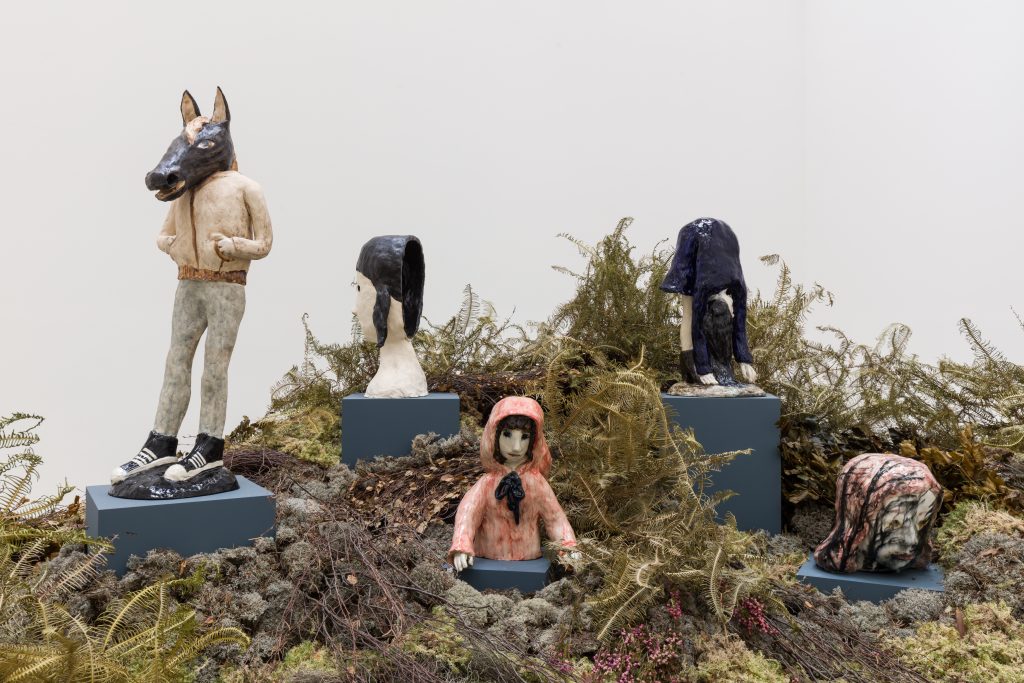Artists
Meet the New Generation of Land Artists Bringing the Earth Inside
These six rising artists are redefining the medium with awe-inspiring, multi-sensory indoor installations.
![Dineo Seshee Bopape’s exhibition “Born in the first light of the morning [moswara’marapo]” at Pirelli HangarBicocca in Milan. Photo: Agostino Osio, courtesy the artist and Pirelli HangarBicocca, Milan. Dineo Seshee Bopape’s exhibition “Born in the first light of the morning [moswara’marapo]” at Pirelli HangarBicocca in Milan. Photo: Agostino Osio, courtesy the artist and Pirelli HangarBicocca, Milan.](https://news.artnet.com/app/news-upload/2024/05/Bopape_Q1A6353-1024x683.jpg)
These six rising artists are redefining the medium with awe-inspiring, multi-sensory indoor installations.
![Dineo Seshee Bopape’s exhibition “Born in the first light of the morning [moswara’marapo]” at Pirelli HangarBicocca in Milan. Photo: Agostino Osio, courtesy the artist and Pirelli HangarBicocca, Milan. Dineo Seshee Bopape’s exhibition “Born in the first light of the morning [moswara’marapo]” at Pirelli HangarBicocca in Milan. Photo: Agostino Osio, courtesy the artist and Pirelli HangarBicocca, Milan.](https://news.artnet.com/app/news-upload/2024/05/Bopape_Q1A6353-1024x683.jpg)
Emily Steer

The term “land art” was made famous by the monumental interventions that artists have carved into the great outdoors since the trend boomed in the 1960s and 70s. But a growing number of artists today are redefining the medium, using earth and natural materials to create awe-inspiring installations inside the gallery walls. Many of them are engaging with far more ancient Indigenous traditions of stewarding the land, which were suppressed by colonial control.
These pieces often play with the scale of the buildings that contain them, and with the tension between human-made and natural forms. Some put forth an idealized symbiosis between plants and humans, while others offer a visually potent image of nature taking back the structures that have encroached upon it. Many invite viewers to question the greedy extraction of Earth’s natural resources that has led to our current state of environmental collapse.
While their intentions differ, the six artists profiled below all turn this most humble of materials into immersive, multi-sensory earth works to be experienced as much as seen. Their creations are utopian and apocalyptic, meditative and mournful, capturing the manifold aspects of the natural world and humanity’s entangled role within it.

Precious Okoyomon, Pre-Sky / Emit Light: Yes Like That (2024). Installation view of “Nigeria Imaginary” at the Nigerian pavilion at the 60th Venice Biennale. Photo: Marco Cappelleti Studio, courtesy of Museum of West African Art (MOWAA).
Known for their ambitious works which combine living plants, sculpted figures, and original soundtracks, Precious Okoyomon has been a significant presence in the two most recent editions of the Venice Biennale. In 2022, the Nigerian-American artist transformed one of the Arsenale’s imposing brick rooms into a winding labyrinth of soil mounds, sculptures, and live butterflies for the main exhibition “The Milk of Dreams.” True to many of Okoyomon’s installations, To See the Earth Before the End of the World (2022) included the invasive vine species kudzu as well as sugar cane, both referencing the connections between enslavement and the land in American history.
At this year’s biennale Okoyomon is showing in the Nigerian pavilion, where their imposing sonic sculpture stands in a courtyard surrounded by soil and plant life. Motion sensors on its steel frame activate a soundtrack of interview recordings with 60 residents of Lagos answering questions like, “Who was responsible for the suffering of your mother?”

Delcy Morelos, Earthly Paradise (2022). Installation view of “The Milk of Dreams” exhibition, 2022 Venice Biennale. Photo: Roberto Marossi, courtesy the artist and Marian Goodman Gallery.
Colombian artist Delcy Morelos also made an impact at the 2022 Venice Biennale with an expansive installation of soil that rose around visitors’ bodies as they walked through a maze of corridors built from it. The all-encompassing feel of the work extended to its bold aroma—the earth was fragrant with other matter, such as cacao, cinnamon, and hay.
Earthly Paradise (2022) called to mind the clean lines and forms of Minimalist sculpture, but Morelos is more inspired by Andean and Amazonian ancestral cultures. “The soil as a sacred element has been forgotten by contemporary civilization,” she told Artnet News. “I like to show the earth/soil in a way that has not been seen, so it appears very delicate, soft, and it smells delicious.” The artist immersed viewers in the material, showing it as something inherently connected to us—a reminder of our return to the earth after death.

Installation view of “Dan Lie: Unnamed Entities” at the New Museum in New York. Photo: Dario Lasagni, courtesy of the artist.
Indonesian-Brazilian artist Dan Lie has also worked extensively with the sense of smell in their earthworks. “Unnamed Entities,” their 2022 solo show at the New Museum in New York, was a heady blend of organic materials, from hemp fabric and hay bales to thousands of cut flowers. The mud in the installation was studded with spores and seeds which naturally sprouted and rotted over the course of the exhibition. The process of decay was intended to disrupt the binary opposition between life and death and to celebrate nature’s cycles of constant transformation.
Lie’s ever-evolving environments of bacteria, fungi, plants, and insects also set out to counter the idea of human dominion on the planet. The artist views these “other-than-human” forces as artistic collaborators in their work. In an interview about the New Museum project, they said: “To experience this work, it is important to be present and inside of it—the ways we can perceive [the other-than-human] go beyond what the eyes can see—smells, difference of atmosphere, and humidity is all part of this.”

Mónica de Miranda, Sónia Vaz Borges and Vânia Gala, Greenhouse (2024) for the Portugal pavilion at the 60th Venice Biennale. © Matteo Losurdo.
“Creole gardens” are the inspiration for the lush installation made for the Portuguese pavilion at this year’s Venice Biennale. Greenhouse was created by a collective comprising visual artist Mónica de Miranda, activist and scholar Sónia Vaz Borges, and choreographer Vânia Gala.
The group’s stunning installation of earth and plants sets up a surreal contrast with the ornate interior of Venice’s Palazzo Franchetti. Mounds of earth nourish a wide range of plant species, from lemon trees to sweeping monsteras. A bed of soil also grounds a video work showing dancers moving through dense vegetation in deep connection with one another’s bodies.
Miranda has described her practice as “an imagined geography,” which allows her to explore her Portuguese-Angolan heritage and broader narratives of belonging and displacement, as well as the fraught, intertwined histories of Portugal and Angola. In Greenhouse, gardening becomes a powerful symbol of personal and political liberation.

Klara Kristalova, installation view of “Strange Clay: Ceramics in Contemporary Art” at the Hayward Gallery in London. Photo: Mark Blower, courtesy the Hayward Gallery.
The Hayward Gallery’s 2022 exhibition “Strange Clay” took ceramic art to its extremes, showcasing an array of large-scale installations that made highly creative uses of the medium. Czech sculptor Klara Kristalova took over a gallery with her forest-like expanse of dried moss, roots, and branches that exuded an earthy scent before the work even came into view.
Far from here (2022) evoked the woods surrounding the artist’s studio in Sweden and the popular setting for traditional fairy tales. The foliage was studded with Kristalova’s playful ceramic sculptures that expanded on the theme, depicting female figures merging with tree trunks and animals dressed in human clothes. The combination of real botanical materials and sculpted stoneware called attention to the formative nature of clay itself, being rooted in both the earth and the human body.
![Dineo Seshee Bopape’s exhibition “Born in the first light of the morning [moswara’marapo]” at Pirelli HangarBicocca in Milan. Photo: Agostino Osio, courtesy the artist and Pirelli HangarBicocca, Milan.](https://news.artnet.com/app/news-upload/2024/05/Bopape_Q1A6206-1024x683.jpg)
Dineo Seshee Bopape’s exhibition “Born in the first light of the morning [moswara’marapo]” at Pirelli HangarBicocca in Milan. Photo: Agostino Osio, courtesy the artist and Pirelli HangarBicocca, Milan.
Many of Bopape’s works address the politics of the land in South Africa. Her installation Mabu,mubu,mmu, sa_ _ke lerole, (sa lerole ke_ _) (2022) at first appeared to be five simple blocks of soil. On closer inspection, they could be seen to have gold leaf, crystals, and herbs sprinkled on their surfaces, evoking the rich complexity of soil, which has historically been exploited for financial gain. For generations, soil was a favored building material for South African homes, too, a community tradition evoked in Bopape’s rammed-earth dome constructions.